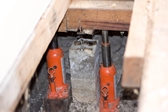
Over time, stump subfloors need to be restumped to make sure the house is evenly supported. Find out what restumping involves.
What is restumping?
Restumping, also known as reblocking, involves resetting (or replacing) the stumps on a house that uses a stump subfloor. This is normally necessary when the house stumps have settled as a result of soil movement, or when wooden stumps have rotted as a result of moisture in the soil. It is also a wise move to restump an older home that will be undergoing major renovations, due to the added strain on the structure of the house.
Restumping any house is a big undertaking and if it’s not handled correctly, it could be very dangerous for you and your house.

Image courtesy of Brent Dayman.
Does my home need restumping?
Signs that your house may need restumping include:
- continually cracking interior walls
- uneven, bowed or ‘soft’ floors
- exterior cracking on brickwork
- doors and windows not functioning correctly.
All houses are different, and are built on ground with different soil conditions. For that reason, every house will display deterioration in different ways. If failed stumping is left untreated though, the end result is the same; partial or total collapse of the structure.
A house can be partially restumped if only certain areas need it, but there is always the risk that a few rotten stumps that were thought to be in good condition may collapse later on, requiring you to restump again. While wooden stumps may look fine, they may well be rotting under the ground. It’s a big job to have to return just to replace one or two stumps!
You can check the condition of a wooden stump by digging down around 10cm next to the stump and scratching at the base. If the wood gives easily, it is a good indicator of damage and will likely need to be replaced before it starts to crumble and drop, no longer supporting the floor above it. You should also look out for high water marks where moisture has been absorbed deep into the wood. If more than 20-30% of the stumps are damaged, it’s almost certainly best to get them all replaced.
How is a home restumped?
The first step is to assess which stumps need to be replaced or reset. This is normally done using a level to assess how even your floors are, and by checking the stumps themselves for movement and deterioration. The house is then gradually and slightly jacked up where the stump that needs to be replaced is, and existing stumps are either packed out to compensate for settling, or are removed and replaced altogether.
Depending on how much movement has occurred, it’s possible that adjustments due to restumping the house will cause doorframes to warp, cracks in plasterwork, tile damage and similar issues.
Wood stumps, steel stumps and concrete stumps
When houses are restumped these days, it is usually with galvanised steel or concrete stumps. These are not susceptible to many of the weaknesses that wood has – they don’t rot, are immune to termites and won’t warp over time. Steel stumps are also adjustable on-site, which is a great advantage when it comes to installation and can save you a great deal of time and effort.
While it can be quite expensive, it’s well worth paying to have it done professionally and to the highest standard. Restumping is a difficult and dirty job, and having it done properly is crucial to the structural integrity of your home.





